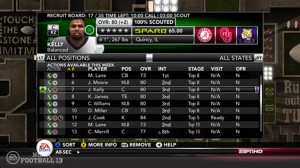NCAA 13 Recruiting Database
 For several years now, most would agree that the recruiting features of NCAA Football have taken huge steps in creating a deep, realistic experience. However, for those of you who are recruiting enthusiasts like me, it can be hard to authenticate certain recruits when you know that their measurables would never lend them to their position in real life. Coupled with the fact that there is little to no growth or weight progression in the game and the end result is some really unrealistic player models.
For several years now, most would agree that the recruiting features of NCAA Football have taken huge steps in creating a deep, realistic experience. However, for those of you who are recruiting enthusiasts like me, it can be hard to authenticate certain recruits when you know that their measurables would never lend them to their position in real life. Coupled with the fact that there is little to no growth or weight progression in the game and the end result is some really unrealistic player models.
We’ve all seen them. The 6’4” wide receivers who weigh 175 lbs or the 6’5” defensive ends that clock in at a whopping 180 lbs. Almost every position is littered with recruits that, even if they physically could exist, would be pushed around on the basketball court of any college or university, much less the gridiron. With high school programs doing a great job of preparing athletes for college ball, more recruits are physically capable of contributing early on in their college career.
While I was down in Orlando for the NCAA 13 Dynasty Community Event, Shaun Mason (@shaunlmason) and myself talked a lot about what a realistic college prospect would physically look like. That topic parlayed into multiple discussions about the progression system as a whole, but unfortunately our ideas were given too late in the cycle for NCAA Football ’13 for the development team to consider such a drastic change. As a result, Shaun and I offered to take a look at their recruit database and see what changes we could make to help the generated recruiting classes make more sense.
What we found was that the minimum weight range for most of the positions was entirely too low for a given height. Much like NCAA Football ’12, this would result in the same ‘bean pole’ prospects being generated, such as the examples mentioned earlier. The approach used to determine appropriate weight and height values was fairly straight forward. A database was compiled of recruits from several recruiting services around the web in which we were able to determine average minimum weights for a given position and height range (It should be noted that we only used the data from real life recruits that received scholarships from FBS universities). Next, to account for the lack of weight progression during the career of a recruit in the game, a small 2-10% buffer was added on to each value to achieve new minimum weight ranges. Comparing our values to the original values being used in the recruit generator yielded fairly large gaps.

